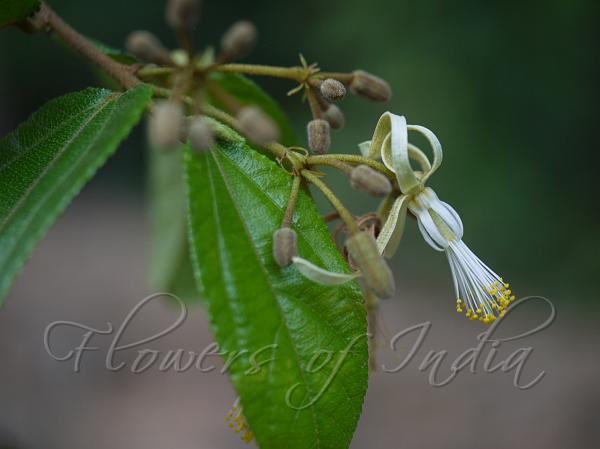|
| Climbing Crossberry |
|

|

| File size | 527871 |
| Original date | 12/28/14 8:57 AM |
| Resolution | 4000 x 3000 |
| Flash | Flash did not fire, auto |
| Focal length | 45.0mm |
| Exposure time | 1/125s |
| Aperture | 2.8 |
| Focus Distance | |
| Metering Mode | Spot |
| Camera make | Panasonic |
| Camera model | DMC-G1 |
| Sensor type | OneChipColorArea |
|
|
|
|
Photo: |
Botanical name: Microcos heterotricha Family: Tiliaceae (Falsa family)
Synonyms: Grewia heterotricha, Grewia ritchiei, Grewia lawsoniana
Synonyms: Grewia heterotricha, Grewia ritchiei, Grewia lawsoniana
Climbing Crossberry is a climbing shrub with leaves
alternate, elliptic-ovate, ovate-lanceshaped to oblong, somewhat
heart-shaped, blunt or rounded at base, rounded-toothed to sawtoothed
at margin, pointed or tapering at tip, 5-13 x 2.5-7.5 cm, rough on both
surfaces, sometimes harshly woolly beneath, 3-nerved; leaf-stalks to
1.3 cm long. Flowers are borne in leaf-opposed umbelled cymes; buds
oblong, pointed, 1.5-1.8 cm long, brown-woolly; flower-cluster-stalks
2.5-11 cm long; flower-stalks 1-2.5 cm long. Petals are
oblong-lanceshaped, pointed, 7-9 mm long, white; glands about 3 mm
long. Sepals are linear-oblong, 1.5-1.8 cm long, densely velvet-hairy
outside. Receptacle about 9 mm long, hairy. Ovary is almost spherical,
about 1.5 mm across, hairy; stigma obscurely 4 or 5 lobed. Berries are
4-lobed, 1-2 cm across, becoming hairless, black-purple and fleshy.
Climbing Crossberry is found in South India and Nicobar Islands.
| Identification credit: Dinesh Valke | Photographed at Doraikatte Hill Top, Karnataka. |
• Is this flower misidentified? If yes,